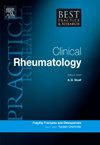系统性红斑狼疮新特征致病途径的转化意义。
IF 4.8
2区 医学
Q1 RHEUMATOLOGY
Best Practice & Research in Clinical Rheumatology
Pub Date : 2023-12-01
DOI:10.1016/j.berh.2023.101864
引用次数: 0
摘要
在过去的几十年里,系统性红斑狼疮(SLE)相关致病途径的特征得到了进一步的描述。因此,开发出了包括贝利木单抗(belimumab)和阿尼洛单抗(anifrolumab)在内的靶向治疗药物,这些药物最近已开始在临床上使用。系统性红斑狼疮的治疗靶点包括干扰素(IFN)信号传导、B-T成本刺激(包括免疫检查点)以及越来越多的B系靶向治疗模式,如针对CD19的嵌合抗原受体(CAR)T细胞或连续抗B细胞靶向治疗。最近的研究表明,基于潜在分子异常特征的患者特征描述(通常通过全面的omics分析进行)可以更好地预测患者的治疗反应,同时也有望揭示驱动系统性红斑狼疮的关键分子机制。系统性红斑狼疮有两个关键特征,即 IFN 和 B 系/浆细胞特征。系统性红斑狼疮治疗的最新进展清楚地表明,针对先天性免疫和适应性免疫可成功治疗这种复杂的自身免疫性疾病。尽管这些特征可能在分子水平上相互作用,并为系统性红斑狼疮的首次选择性治疗提供了基础,但这些不同的治疗方法是否会在某些患者亚群中显示出不同的治疗反应,还有待进一步明确。事实上,尽管为系统性红斑狼疮的创新治疗提供了大量新线索,但在量身定制的治疗策略中协调大数据将有助于更好地理解和治疗这种具有挑战性的自身免疫性疾病。本综述将概述系统性红斑狼疮发病机制的最新进展、通过大数据和机器学习分析得出的相关见解,以及开展临床试验的技术改进,最终目标是通过转化研究改善患者的治疗效果。本文章由计算机程序翻译,如有差异,请以英文原文为准。
Translational implications of newly characterized pathogenic pathways in systemic lupus erythematosus
Improved characterization of relevant pathogenic pathways in systemic lupus erythematosus (SLE) has been further delineated over the last decades. This led to the development of targeted treatments including belimumab and anifrolumab, which recently became available in clinics. Therapeutic targets in SLE encompass interferon (IFN) signaling, B-T costimulation including immune checkpoints, and increasing modalities of B lineage targeting, such as chimeric antigen receptor (CAR) T cells directed against CD19 or sequential anti-B cell targeting. Patient profiling based on characterization of underlying molecular abnormalities, often performed through comprehensive omics analyses, has recently been shown to better predict patients’ treatment responses and also holds promise to unravel key molecular mechanisms driving SLE.
SLE carries two key signatures, namely the IFN and B lineage/plasma cell signatures. Recent advances in SLE treatments clearly indicate that targeting innate and adaptive immunity is successful in such a complex autoimmune disease. Although those signatures may interact at the molecular level and provide the basis for the first selective treatments in SLE, it remains to be clarified whether these distinct treatments show different treatment responses among certain patient subsets. In fact, notwithstanding the remarkable amount of novel clues for innovative SLE treatment, harmonization of big data within tailored treatment strategies will be instrumental to better understand and treat this challenging autoimmune disorder. This review will provide an overview of recent improvements in SLE pathogenesis, related insights by analyses of big data and machine learning as well as technical improvements in conducting clinical trials with the ultimate goal that translational research results in improved patient outcomes.
求助全文
通过发布文献求助,成功后即可免费获取论文全文。
去求助
来源期刊
CiteScore
9.40
自引率
0.00%
发文量
43
审稿时长
27 days
期刊介绍:
Evidence-based updates of best clinical practice across the spectrum of musculoskeletal conditions.
Best Practice & Research: Clinical Rheumatology keeps the clinician or trainee informed of the latest developments and current recommended practice in the rapidly advancing fields of musculoskeletal conditions and science.
The series provides a continuous update of current clinical practice. It is a topical serial publication that covers the spectrum of musculoskeletal conditions in a 4-year cycle. Each topic-based issue contains around 200 pages of practical, evidence-based review articles, which integrate the results from the latest original research with current clinical practice and thinking to provide a continuous update.
Each issue follows a problem-orientated approach that focuses on the key questions to be addressed, clearly defining what is known and not known. The review articles seek to address the clinical issues of diagnosis, treatment and patient management. Management is described in practical terms so that it can be applied to the individual patient. The serial is aimed at the physician in both practice and training.

 求助内容:
求助内容: 应助结果提醒方式:
应助结果提醒方式:


